

Field campaigns are hectic. Everyone is always thinking ahead to the next flight, rarely taking the opportunity to experience the, often times, incredible location they are operating from.
ORACLES has been no exception. On September 10, the ER-2 joined the P-3 in the sky, measuring aerosols and clouds from above. Since then, it has been a mad race to the finish: planning flights, analyzing data, fixing instruments, deliberating over last-minute plan changes, coordinating spatial coincidences between the planes mid-flight.
On flight days the ER-2 (the plane that the instrument – AirMSPI – that I work with, is on) has a “hands-on” call before the sun comes up. Meanwhile, the principal investigators spend 30 minutes discussing whether the plan they spent hours devising the day before will hold up in the face of an unpredictable environment. At 6 a.m. (or thereabouts) there’s a call with the pilots where we discuss the plan for the day, and then the pilot is off to prepare for a long day. The aircraft is towed out to the tarmac and, eventually, around 9 a.m. the plane – complete with a pilot in a spacesuit – is off for a full day of science-ing.
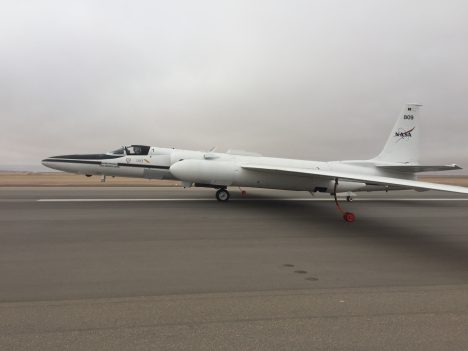
The ER-2 aircraft preparing for a flight, as seen from the “chase car”. Credit: Mike Tosca.
In addition to all of the above, we’ve also been mentoring an exceptional group of seven Namibian and South African interns. Their eagerness to learn has been inspiring. Life-affirming is hardly a strong enough word to describe how the experience has affected me.
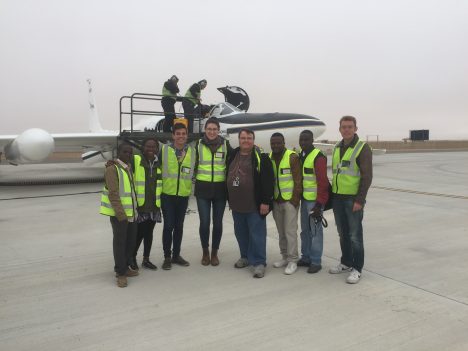
Namibian interns in front of the ER-2 aircraft, checking out our instrument: “AirMSPI”. Credit: Walvis Bay airport employees.
Amidst all of the commotion, the stress, the anxiety, the data-crunching, the ever-elusive “hard down day” appears out of the ether, a seeming ray of light emerging from an overcast Swakopmund sky. Monday, September 19 was one of those days. And it proved to be one of those ephemeral times when the hard working scientists were able to explore a bit of the region of the world they have called home for four weeks.
We all were treated to a truly Namibian experience. One of our amazing interns took us to “the location”- a suburb of Swakopmund where the paved roads and German-inspired buildings of the town center gradually morph into smaller residential dwellings and dusty streets on their way toward the vast Namib desert. Children play in the streets, music echoes out of lively bars, neighbors laugh and talk together over their fences. We all shared a traditional Namibian meal of Namibian chicken, tripe, spinach, “pap”, smashed beans, Windhoek beers, and of course, a delicious “braai” (a Namibian and South African type of barbecue) at the accommodating Hafeni Restaurant. The braai was even cooked by hand by our intern Ismael in the backyard of the restaurant. Suffice to say, our tummies were very satisfied at the end of the day.

A group of hungry scientists outside Hafeni Restaurant in the Mondesa neighborhood of Swakopmund. Credit: restaurant staff
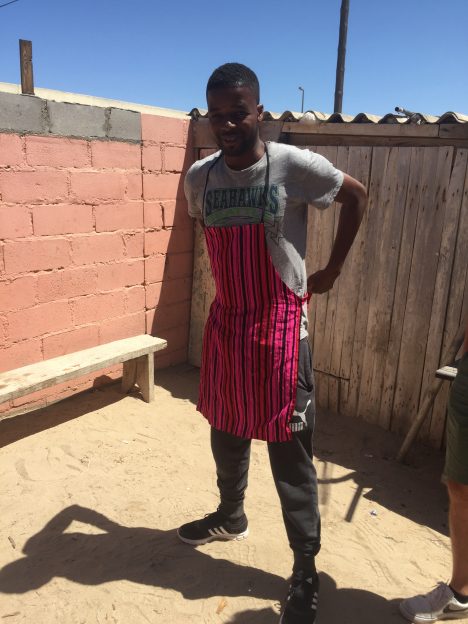
Our talented intern, Ismael, cooking us a traditional Namibian braai. Credit: Mike Tosca
It was one of those experiences I’ll never forget. Kind of like the sunset every night over the Atlantic Ocean from Swakopmund Beach. Or being one of the first people to see the imagery that our remote-sensing instrument has collected from the previous day’s flight.

A dusty, smokey, sunset over the Atlantic Ocean from the Namibian coast. Credit: Mike Tosca
It’s day 11 of the NASA ORACLES Student Shadowing Program and I’m still bursting with excitement; what an absolute wonder to watch the team in action. As a PhD student from South Africa it’s great to be exposed to the latest research in the field of atmospheric science and have the opportunity to be submerged in the brilliance of the science on the go.
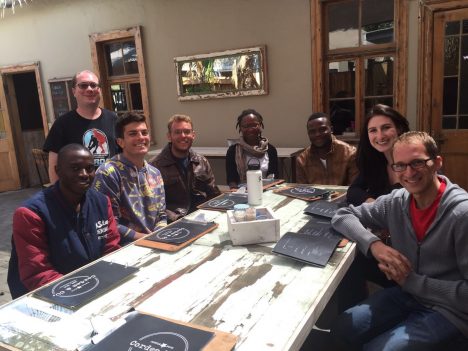
Danitza Klopper (second from right) with a group of NASA scientists and shadowing Namibian and South African students. Photo credit: Cordes Cafe staff
Coordinating a group of over 100 vivacious and enthusiastic scientists, engineers, data specialists, pilots, flight crew and technicians is a mammoth task which seems to be taken in the stride of the principal investigators of the ORACLES mission team. Not to mention hosting seven eager students and keeping us busy. We feel like kids again, in the shadows of our heroes, smitten and in awe; doting our NASA backpacks and stickers on our laptops, eagerly watching them fiddle with their high-tech instruments and programs. One could expect to be completely overwhelmed and obscured with so much brainpower in one room, but we were met by a high-spirited and humble group of human beings who are actively pouring their insight, knowledge and passion into this mission to help explain the complex interactions between aerosols and clouds.
We get to see the hard work that goes into it all, and although sleep is a valuable commodity and “hard down days” are sacred, when there’s work to be done fingers tap away at keyboards, markers squeak on drawing boards and you can all but smell the firing of neurons. What an environment to be submerged in! Networking, exchanging and watching science in action; this is an invaluable experience that will never be forgotten and illustrates the hard work that goes into these missions which make large amounts of invaluable data available to researchers around the world to interpret the mind-boggling nature of the atmosphere.
In true NASA spirit I thought it would be apt to describe the NASA-ORACLES team with the accronym, SUPERCOOL (Scientists who Understand that Passion and pERseverance Coincides with resOlving the Obscure and unexpLained).
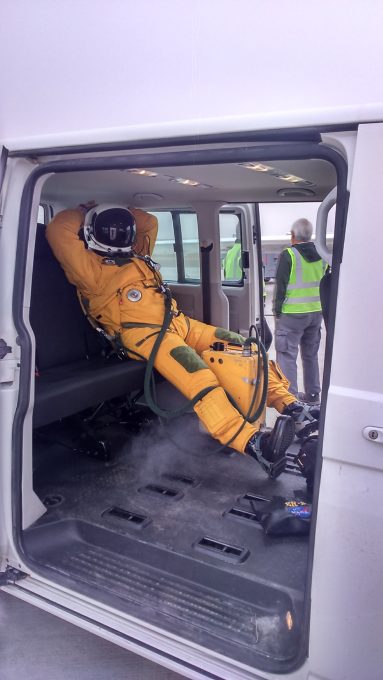
ER-2 pilot in the van before flight. Credit: Danitza Klopper
We finally launched the ER-2 on its first science mission yesterday after two weeks waiting for fuel, parts and equipment. I got the privilege of sitting in the driver’s seat because Greg “Coach” Nelson got to deliver the jet from its last fuel stop in Recifé, Brazil. We’re the two ER-2 pilots here for ORACLES, so we’ll take turns flying and driving the chase car.
The mission routine was like most on other deployments, but it’s exciting because we’re in a new place, on a new, important mission, with a new combination of sensors and with some new people on the science team: Scientists, engineers, maintainers, ground support folks and even aircrew (Coach’s first NASA deployment).
The pilot not flying on mission day is called the “mobile” and helps with the flight planning, checks weather, sets up the ER-2 cockpit, does the walkaround and also drives a radio-equipped car behind the jet as it taxis, takes off and lands. When the ER-2 is airborne and collecting scientific data, the mobile hangs out with the science team and communicates with the pilot via satellite phone and radio about changes to the science plan, weather and instrument health.
The pilot who gets to fly has the tougher, high-risk work for the day, but you wouldn’t know it watching the routine from the ground. After the three-hours-prior-to-takeoff mission brief, the flying pilot shifts into the prep mode, which involves a lot of sitting still.
Each of NASA’s four ER-2 pilots has his own pre-mission routine. My routine for yesterday’s flight started at the Swakopmund Hotel, where the scientists, pilots and operations folks are staying here in Namibia. My pre-flight routine is roughly the same every high flight.

Last-second admin before suiting up. Credit: Stu Broce
I wake up, shower, shave meticulously so the face seal in my helmet makes good contact. After getting dressed, I eat a high-energy, high-fiber breakfast (more on that later) of fruit, cereal, yogurt and perhaps some bread. I ride with the mobile to the airport (30 minutes here in Namibia, mostly on a long dirt road), brief, and study the final plan and checklists. Then I kind of zone out into my happy place to mentally prepare for the mission. I hit the restroom one last time (my body knows what the high-fiber breakfast meant) then head to the life support room. Here it’s a small room off the hangar with a couple of folding metal chairs and a simple rack where our pressure suits hang.
The pressure suit is the same one shuttle astronauts wore to and from orbit and we climb in them from a long zipper on the back that runs from our crotch to just below the neck ring. After I change into my special long johns and socks, and attach my UCD (Urine Collection Device: A latex tube with a condom-like attachment on one end and a valve on the other end) to me, I don the suit with the help of a life support technician — in yesterday’s case it was Haku.
First, I insert my legs, then click my UCD valve into a tube that exits my left suit leg through another valve. Next I shove my arms into the sleeves and with a little help, I “dive” through the zipper putting my head through the neck ring. It’s a bit awkward and kind of like being born, but in reverse. A torso harness with stowed flotation devices and parachute/survival kit connections goes on over the pressure suit. After the harness is strapped tight and zipped up, I head to the chair.
Then I just sit there. The helmet comes next, then the gloves, each connecting to the suit on rings that rotate on ball bearings so we can twist our wrists and head from side to side. After they’re attached, it’s time to close the visor to start our 1-hour pre-breathing of pure oxygen—decompression sickness from climbing to high, too fast is a constant threat. When that visor comes down, we don’t get to scratch our wipe sweat from our faces (or any other part of our bodies), or get that single hair or eyelash off our noses for the next several hours—9 to 10 for ORACLES missions. Also, with the visor down, all sounds except for the hissing of oxygen in my bubble are muffled and I cant hear what people are saying.
Then I continue to sit there while techs put my boots and spurs (for the ejection seat to work properly), connect me to a portable oxygen supply/cooler and run leak checks that involve inflating the suit to a psi or two, then double-check everything. Then it’s a short walk to the minivan where I stumble into the back seat while attached with hoses to the oxygen supply/cooler that Haku or Corky carries behind me.

My view waiting to hop in the jet for ORACLES ER-2 mission one. Credit: Stu Broce
Then I just sit there for the short drive to the waiting ER-2. When the cockpit is ready, I stumble out of the minivan, walk to the ladder, climb up and gingerly wedge myself into the cockpit.
Then I just sit there while the techs strap me in and run final checks on the suit. That takes about ten minutes and they work up a sweat—some of the 13 connections between me and the jet are hard to get to, especially with a big pilot filling the cockpit (I am the worlds largest ER-2 pilot).
Once I’m strapped in and life support is satisfied the suit’s working properly, they put my water bottles and food on the consoles behind my hips. Then I scan the cockpit quickly, which is generally unnecessary: The mobile has already seat up every switch in the cockpit, run all the pre-start checklists, entered every waypoint into the navigation system, energized the sensors and even put a sharpened pencil in its holder on the control column.
I give a thumbs when I’m ready to go. Life support switches the cooling hose from the portable unit to the aircraft supply hose and the mobile climbs up, shakes my hand then closes the canopy over me before climbing down and running over to the chase car.
From then on my job is, literally, to read checklists and respond accordingly…and apply a little flying skill and experience. More on that later.
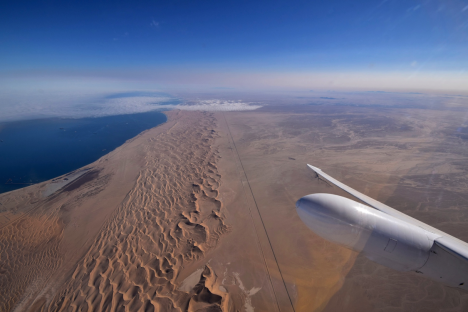
Swakopmund is under the clouds in the photo, at the end of the straight dirt road that runs 20 miles along the dunes between town and Walvis Bay Airport. Credit: Stu Broce
Stu Broce is one of NASA’s ER-2 pilots based out of Armstrong Flight Research Center.
August 31, 2016
I usually hate putting in earplugs, but the roar of the P-3 plane makes me get over my aversion quickly. We’re a little less than an hour away from take-off, and people are moving from the hangers that are serving as our base of operations at Walvis Bay Airport to the aircraft. Before joining them, one other graduate student and I have to complete a short safety briefing — for both of us, this will be our first journey on the P-3.
I’m currently finishing up my first year as a graduate student in the Department of Atmospheric Sciences at the University of Washington, Seattle. My advisor, Professor Rob Wood, is the deputy principal investigator of ORACLES, and beyond helping him out in the field, my role will be using the data we collect to better understand the interaction between smoke and cloud particles over the southeast Atlantic.

Me (Michael Diamond) and Sam LeBlanc (a scientist working at the NASA Ames sun photometer instrument group) taking dueling photos from aboard the P3. Photo credit: Sam LeBlanc and Michael Diamond. You can guess in which order 🙂
After safety training is complete, we’re able to board the plane. There are no beverage carts, movies, or reclining seats on this flight, but we do have some other perks. We have a microwave and — in my opinion more importantly — a coffeemaker in the back of the plane. There are screens, but instead of showing Zootopia or season 3 of Friends, these show the data our instruments are collecting and have various controls depending on the instrument. Racks of instrument machinery take the place of some rows of seats. We even have a version of in-flight WiFi, although this version has a somewhat more limited offering: forward and nadir (directly below the plane) cameras, a few live-streams of the data being collected, some satellite images, and the flight map.
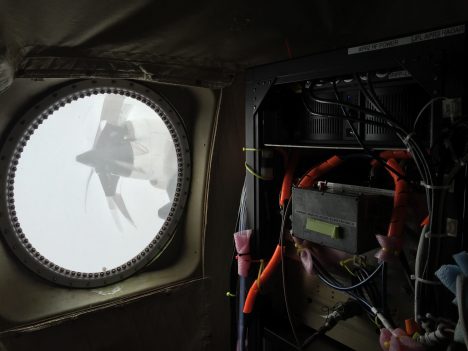
One of the instruments aboard the P-3 with the P-3’s propeller visible out the window. Photo credit: Michael Diamond
This will technically be our second official science flight of the ORACLES campaign, although some people have been calling it “1b” because the first flight had to turn around early due to a mechanical issue. Conditions are fairly good for flying today, with the caveat that there are some mid-level “altocumulus” clouds in our flight path. The “cartoon” version of the system we’re studying would be uniform, low-level stratocumulus clouds (incredibly long expanses of relatively thin, fluffy clouds) overlain by a layer of smoke produced from fires in central Africa and lofted over the Atlantic Ocean by the prevailing wind patterns. This stratocumulus deck reflects a lot of sunlight during the day and thus plays an important role in cooling Earth’s climate, which is why it’s so important to understand how the clouds are affected by largely man-made fires. The mid-level clouds add another wrinkle to this already complex system.
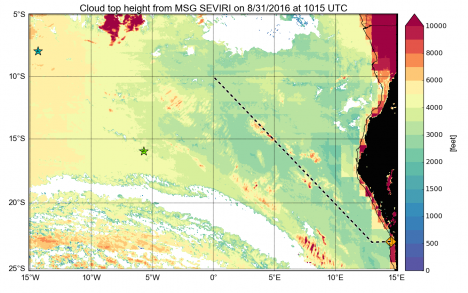
Map of the southeast Atlantic and coastal west Africa with our flight track marked in black/white dashes. The mid-level clouds can be seen in the satellite-estimated cloud top heights as the yellow-to-red colors around 5° East and 15° degrees South. Walvis Bay, our starting point, is marked as the orange diamond.
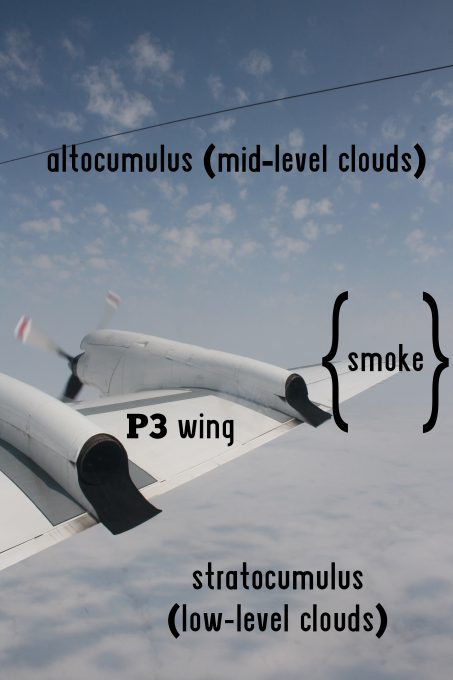
Schematic from outside the P-3 window of mid-level clouds, the smoke layer, and the low-level stratocumulus clouds. Credit: Michael Diamond
In addition to flying over the stratocumulus clouds, we also fly through and below them to take advantage of the unique capabilities of each of the P-3 instruments and to study the marine boundary layer, which is an atmospheric science term referring to the shallow, extremely well-mixed layer of air just over the ocean and topped by the stratocumulus clouds. As anyone who’s been on a commercial airliner can attest, cloud layers are turbulent, and the marine boundary layer is also very turbulent, so this can lead to a rather bumpy ride.
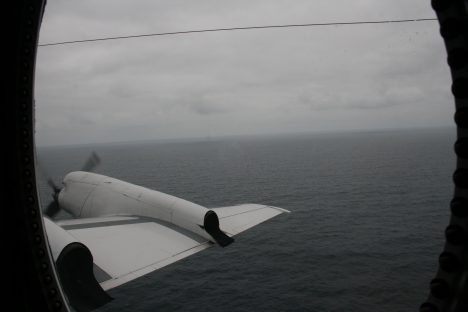
View of the marine boundary layer with stratocumulus clouds above and the Atlantic Ocean below from outside the P-3 window. Photo credit: Michael Diamond
Despite getting a bit high-altitude-over-sea sick, I enjoyed my first flight on the P-3, and the initial indication is that we collected some high-quality data. If September’s flights are as successful as flight “1b,” we’ll be coming back with a ton of great climate information. And then comes the hardest part: analyzing all that data!
As the soaking rains of the summer wet-season subside in early July, the vast savannas of the southern half of the African continent dry out and turn from green to brown to a crispy yellow. Local farmers take advantage of the dried-out vegetation and burn the aged remains of crops before plowing and harrowing in an effort to return vital nutrients to the soil. The result of all this dry-season burning is a large, thick, persistent plume of smoke that stretches from the eastern coasts of Mozambique out over the southern Atlantic Ocean, sometimes reaching past Ascension Island on its way to Brazil. In many years, this plume persists, almost unbroken, from August through October.
A team of 100 plus scientists from NASA and universities are here on the far west coast of Namibia in the small desert resort town of Swakopmund to study the impact that this expansive plume of smoke has on low cloud dynamics over the Atlantic Ocean. Our mission is called the Observations of Aerosols Above Clouds and their Interactions, or ORACLES.
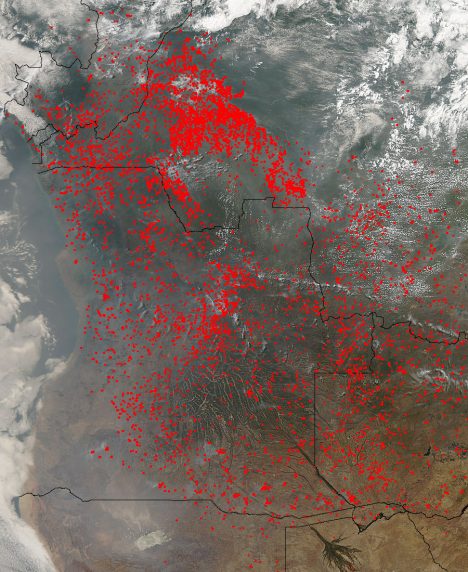
A MODIS satellite image from 21-08-2013 showing abundant fire (red dots) and an expansive plume of smoke originating in Angola and stretching out over the open Atlantic where it interacts with low clouds. Credit: NASA
We’re using two research aircraft – the P-3 and the ER-2 (shown below) – equipped with over a dozen instruments and team members from a more than a dozen countries, to study these interactions from above, below and even within the clouds and smoke. I personally work with an instrument that is on-board the ER-2, but, just last week (August 31), the P-3 aircraft had its first successful research flight over the open Atlantic and flew through some impressive regions of smoke.

Scientists and engineers working on the P-3 aircraft which is currently stationed at Walvis Bay International Airport, Namibia. Photo by Mike Tosca.
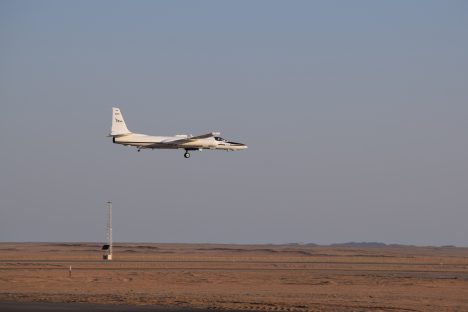
A spectacular image of the ER-2 aircraft landing at Walvis Bay International Airport on August 26, 2016. Photo by Brian Rheingans.
Before arriving in Swakopmund, I, personally, had the great privilege of seeing this impressive plume of smoke overland and in “the wild”. I spent three days touring the incredible Etosha National Park in far northern Namibia where I was able to see a menagerie of megafauna (elephants, lions, giraffes, oh my) juxtaposed against an almost surreal background of grey, smoky skies. It goes without saying that the thick smoke – which originated from biomass burning in many cases hundreds of miles away in Zambia and beyond – helped produce some of the most spectacular sunsets I’ve ever seen.
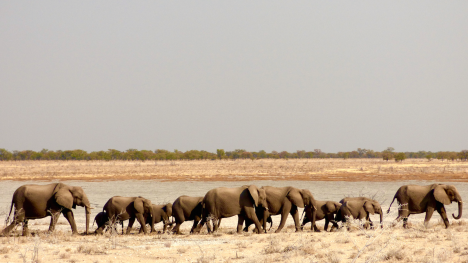
A family of elephants in Etosha National Park is an impressive foreground subject to a gray sky filled with biomass burning smoke originating in central Africa. Photo by Mike Tosca.
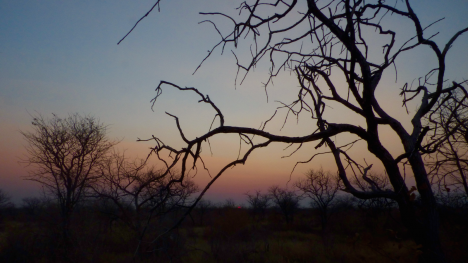
A brilliant sunset viewed through a layer of biomass burning smoke from Etosha National Park on August 18, 2016. Photo by Mike Tosca.
This research campaign is just ramping up, but the smoky skies and the cloudy Atlantic are already proving to be the perfect real-life research laboratory for questions about the complex and not-well-understood interactions between smoke particles and low clouds. I think I speak for the scientific community when I say that I’m looking forward to the incredible and first-of-their-kind data that are sure to come out of this campaign over the next month or so.
Mike Tosca is an research scientist at NASA’s Jet Propulsion Laboratory in Pasadena, California.